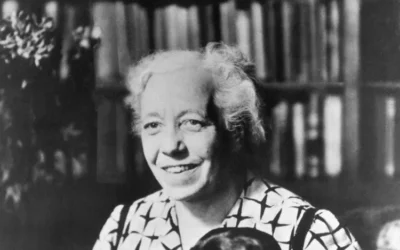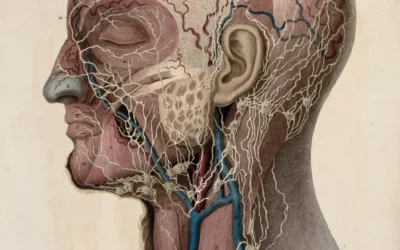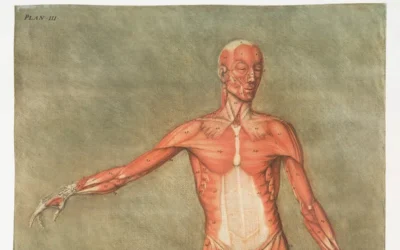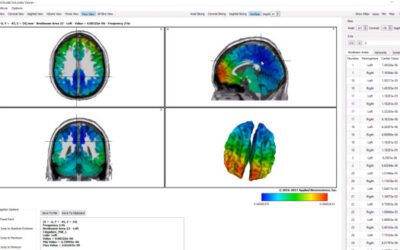Your heart is racing at 3 AM again. You've tried the breathing exercises – in for four, hold for four, out for four. You've downloaded the meditation apps. You've done the yoga, cut the caffeine, exercised regularly. Hell, you could probably teach a masterclass on "coping skills" at this point. Yet here you are, wide awake, body vibrating with that familiar electric dread, Googling "anxiety therapist near me" and wondering why nothing fucking works. Here's what the self-help industrial complex won't tell you:...
Healing from Abuse: A Comprehensive Guide to Recovery and Understanding Trauma

Understanding Abuse and Its Impact on the Mind and Body
Abuse recovery is a profound journey of healing that encompasses multiple dimensions of human experience. At Taproot Therapy Collective in Birmingham, Alabama, we understand that recovering from abuse requires more than traditional talk therapy approaches. We are the premiere providers of therapy for severe and complex trauma, PTSD, anxiety and depression. We provide EMDR, brainspotting, somatic, and, Jungian therapy as well as QEEG, brain mapping and neurostimulation.
Abuse fundamentally disrupts our sense of safety, trust, and connection to our authentic selves. Whether you’ve experienced childhood abuse, domestic violence, sexual assault, emotional manipulation, or other forms of interpersonal trauma, the effects extend far beyond the initial events. The body brain, residing beneath our cognitive brain, holds valuable information and influences our cognitive processes. It regulates our deep emotional responses, signaling hunger, anger, fear, or sadness. This subcortical brain, which includes the basal ganglia, is where trauma tends to be stored.
The Neuroscience of Abuse and Trauma Storage
Modern neuroscience reveals that traumatic experiences from abuse become encoded in multiple brain systems simultaneously. When we experience triggers related to past trauma, such as post-traumatic stress disorder (PTSD) or anxiety, our reactions are not a conscious choice but rather a product of the body brain’s activation. The fight-or-flight response kicks in, signaling danger or threatening situations. This understanding is crucial for survivors because it helps normalize the intense physical and emotional reactions that can arise seemingly out of nowhere.
The subcortical brain systems where abuse trauma is stored operate below conscious awareness, which is why traditional cognitive approaches alone often fall short in providing lasting relief. At Taproot Therapy Collective, our brain-based medicine approach recognizes this neurobiological reality and offers targeted interventions that work with both conscious and unconscious processing systems.
Conceptualizing Abuse: Moving Beyond Victim and Survivor Labels
The Complexity of Abuse Dynamics
Abuse rarely occurs in isolation—it typically involves complex patterns of power, control, and manipulation that can distort a person’s sense of reality. Understanding these dynamics is essential for recovery. Abuse can take many forms:
Physical Abuse: Direct harm to the body through hitting, restraining, or other physical violence Emotional/Psychological Abuse: Systematic undermining of self-worth through manipulation, gaslighting, threats, or humiliation Sexual Abuse: Any unwanted sexual contact or exploitation, regardless of relationship to the perpetrator Spiritual/Religious Abuse: Using religious beliefs or practices to control, manipulate, or harm Financial Abuse: Controlling access to financial resources as a means of power and control Neglect: Failure to provide basic physical or emotional needs, particularly devastating in childhood
Breaking the Shame Cycle
One of the most insidious aspects of abuse is how it creates internal shame narratives that can persist long after the abuse ends. Survivors often struggle with questions like “Why didn’t I leave?” or “How could I let this happen?” Our depth psychology approach recognizes that these responses represent normal adaptations to abnormal circumstances.
Until we deal with trauma we cannot live authentically or trust our intuition. When we are traumatized our gut reactions and changes in mood are problematic and untrustworthy. This insight helps explain why abuse survivors often experience confusion about their own perceptions and feelings—the trauma has disrupted their natural capacity for self-trust and intuitive knowing.
Evidence-Based Therapeutic Approaches for Abuse Recovery
EMDR: Processing Traumatic Memories
Eye Movement Desensitization and Reprocessing (EMDR) represents one of the most well-researched and effective treatments for trauma resulting from abuse. EMDR therapy is clinically proven to be effective in the treatment of traumatic life experiences. It’s been tested in more than 20 scientifically controlled studies. Plus, it enhances the impact of most other types of therapy.
During EMDR sessions, clients focus on disturbing memories while engaging in bilateral stimulation (typically eye movements), which helps the brain process traumatic experiences in a new way. This approach is particularly powerful for abuse survivors because it works directly with the stored trauma without requiring extensive verbal processing, which can sometimes feel overwhelming or retraumatizing.
The EMDR process involves eight distinct phases that systematically address past traumatic events, current triggers, and future scenarios. Many clients experience significant relief in fewer sessions compared to traditional talk therapy approaches.
Brainspotting: Accessing the Deep Brain
Brainspotting is based on the premise that “where you look affects how you feel.” During a brainspotting session, the therapist guides the client to focus on a specific eye position, known as a brainspot, while simultaneously processing a traumatic memory or disturbing emotion.
Brainspotting therapy is particularly effective for abuse survivors because it directly accesses subcortical brain regions where trauma is stored. All of our therapists are trained in Brainspotting, a fast and effective treatment for trauma. This modality can help process experiences that may be too overwhelming or fragmented for verbal therapy approaches.
Our Birmingham area practice was among the first to bring brainspotting to Alabama, and our therapists have completed advanced Phase 2 training, providing you with the highest level of expertise available in the region.
Somatic Experiencing: Healing Through the Body
Somatic Experiencing (SE) recognizes that trauma gets trapped in the nervous system and must be released through the body. Somatic Experiencing (SE) is a body-oriented therapy developed by Dr. Peter Levine based on his observations of how animals in the wild recover from trauma. SE focuses on gently releasing survival energies stuck in the body and nervous system after trauma.
For abuse survivors, somatic approaches can be particularly healing because abuse often involves violations of physical and energetic boundaries. SE helps restore the natural flow of energy through the nervous system, allowing the body to complete interrupted defensive responses and return to a state of regulation.
Emotional Transformation Therapy (ETT)
ETT therapy represents a cutting-edge approach that combines light therapy with brain-based techniques. ETT therapy, also known as Emotional Transformation Therapy, is a cutting-edge approach that combines somatic and cognitive psychology, neuroscience, and brain based medicine to create unprecedently fast emotional healing and personal transformation.
This innovative modality uses specific wavelengths of colored light to activate neural networks associated with emotional processing, making it particularly effective for survivors who have difficulty accessing or expressing emotions related to their abuse experiences.
Internal Family Systems (IFS) for Complex Trauma
Abuse often creates internal fragmentation as different parts of the self develop to cope with overwhelming experiences. Internal Family Systems therapy offers a compassionate framework for understanding and healing these internal divisions.
IFS is effective for a wide range of trauma-related issues, including PTSD, anxiety, depression, substance abuse, and eating disorders. The deep, meditative states accessed in IFS likely engage similar brain networks as mindfulness meditation, which is known to strengthen emotional regulation, attention, and memory integration capacities in the prefrontal cortex.
Specialized Approaches for Complex Abuse Recovery
NARM Therapy for Developmental Trauma
NeuroAffective Relational Model (NARM) therapy specifically addresses the impacts of early abuse and neglect. The Neuro-Affective Relational Model (NARM) is an advanced therapeutic approach designed to address developmental trauma and attachment issues. NARM integrates top-down (cognitive) and bottom-up (somatic) interventions to work with the link between psychological issues and the body.
This approach is particularly valuable for survivors of childhood abuse, as it addresses how early traumatic experiences shape our capacity for connection, self-regulation, and authentic self-expression.
Lifespan Integration Therapy
Lifespan Integration therapy offers a unique timeline-based approach to healing that can be especially helpful for survivors of chronic or repeated abuse. This modality helps integrate fragmented memories and experiences across the lifespan, creating a more coherent sense of self and personal history.
Brain Mapping and Neurostimulation
Our QEEG brain mapping services provide objective insight into how abuse trauma has affected brain function. A map of the brain is made with qEEG. The brain map shows clinicians where the brain functioning well and where it is getting “stuck”. This can tell you more information about your diagnosis than testing alone.
Based on your individual brain map, personalized neurostimulation protocols can help restore optimal brain function and accelerate healing from trauma-related symptoms.
Understanding the Trauma Response System
Polyvagal Theory and Abuse Recovery
Understanding how abuse affects the autonomic nervous system through polyvagal theory provides crucial insight into recovery. The nervous system’s response to abuse often becomes stuck in protective states—hypervigilance (sympathetic activation) or shutdown (dorsal vagal activation)—that continue long after the abuse ends.
Our alternative medicine and holistic health approaches incorporate nervous system regulation techniques including breathwork, meditation, and somatic practices that help restore the capacity for safety and connection.
The Window of Tolerance
Abuse recovery involves expanding what trauma specialist Dr. Dan Siegel calls the “window of tolerance”—the zone where we can remain present and regulated even when experiencing challenging emotions or memories. Our therapists help clients gradually expand this window through various evidence-based techniques.
Supporting Resources and Self-Care Strategies
National Resources for Abuse Survivors
RAINN (Rape, Abuse & Incest National Network): The nation’s largest anti-sexual violence organization offers 24/7 support through their National Sexual Assault Hotline at 800.656.HOPE (4673) and online chat support. RAINN provides comprehensive information about therapy options and recovery resources for survivors.
National Center for PTSD: Part of the U.S. Department of Veterans Affairs, the National Center for PTSD offers extensive educational resources about trauma recovery, including information about evidence-based treatments and self-care strategies.
National Child Traumatic Stress Network: NCTSN provides specialized resources for child abuse survivors and their families, including information about complex trauma and developmental impacts of abuse.
National Alliance on Mental Illness (NAMI): NAMI’s PTSD resources include information about treatment options, support groups, and family resources.
Building a Personal Recovery Plan
Recovery from abuse is not a linear process—it involves cycles of growth, integration, and sometimes temporary setbacks. Our therapists work with you to develop personalized recovery plans that may include:
- Individual therapy using multiple modalities
- Group therapy for peer support and shared healing
- Medication evaluation when appropriate
- Somatic practices and body-based healing
- Meditation and mindfulness training
- Creative and expressive therapies
- Family therapy to address relationship impacts
The Journey from Surviving to Thriving
Reclaiming Your Authentic Self
Often the real gift of therapy doesn’t come from the things that we get rid of, but the things that we gain. Most of us live our life in a mental fog that we can’t see out of. We go through our routine just surviving while not being alive. Therapy can often help us clear this fog.
Abuse recovery ultimately involves reconnecting with your authentic self—the person you were meant to be before trauma shaped your responses to life. This process involves developing new neural pathways, healing relationship patterns, and cultivating a trustworthy internal compass.
Post-Traumatic Growth
Many abuse survivors discover that healing can lead to post-traumatic growth—positive psychological changes that emerge from working through trauma. These may include:
- Deeper appreciation for life and relationships
- Increased emotional resilience and regulation skills
- Greater sense of personal strength and agency
- Enhanced spiritual or existential understanding
- Improved capacity for intimacy and authentic connection
Specialized Support for Alabama Residents
Teletherapy Across Alabama
We provide teletherapy services throughout Alabama, making specialized abuse recovery treatment accessible regardless of your location. Our secure, HIPAA-compliant platform ensures privacy and confidentiality while connecting you with Birmingham’s most experienced trauma therapists.
Community Resources in Birmingham
Living in Birmingham provides access to additional community resources including:
- UAB Hospital’s trauma-informed medical care
- Local support groups and community organizations
- Faith-based counseling that honors your spiritual beliefs
- Specialized services for LGBTQIA+ individuals and military veterans
Creating Safety in Recovery
Physical and Emotional Safety
Recovery from abuse begins with establishing safety—both physical and emotional. This might involve:
- Safety planning for those still in dangerous situations
- Creating trauma-informed living environments
- Developing healthy boundaries in relationships
- Building internal emotional regulation skills
- Accessing legal advocacy when needed
Therapeutic Safety
Our therapists are trained in trauma-informed care principles that prioritize your safety and agency throughout the healing process. We understand that therapy itself can feel vulnerable for abuse survivors, and we work to create a therapeutic environment where you feel truly held and supported.
The Neurobiology of Healing
How the Brain Heals from Abuse
Understanding how trauma affects the nervous system through polyvagal theory informs therapeutic approaches that address both psychological symptoms and physiological dysregulation. This integration proves particularly valuable for individuals whose mental health symptoms include physical manifestations like chronic pain, digestive issues, or autoimmune conditions that may reflect unresolved psychological stress.
Modern neuroscience shows us that the brain maintains neuroplasticity throughout life, meaning healing and change remain possible regardless of how long ago abuse occurred. Our neuroscience-informed approaches work with the brain’s natural capacity for healing and reorganization.
Integration and Wholeness
The goal of abuse recovery is not to forget what happened, but to integrate these experiences in a way that no longer controls your present-moment life. Intuition and trauma are both have their origin in the subcortical brain. The subcortical brain is the oldest part of the brain that stores information that we can only be partially conscious of. Healing involves restoring access to your intuitive wisdom and authentic responses to life.
Getting Started with Abuse Recovery
Taking the First Step
Beginning therapy for abuse recovery requires tremendous courage. We honor that courage and provide multiple ways to get started:
- Schedule a consultation to discuss your needs and goals
- Learn about our therapists’ specializations to find the best fit
- Explore our treatment modalities to understand your options
- Contact our office at (205) 598-6471 for immediate support
Working with Insurance and Accessibility
We accept various insurance plans and work to make treatment accessible. Our team can help you understand your coverage and explore options for receiving the care you need.
Continuing Your Journey
Recovery from abuse is a lifelong journey of growth and healing. Our therapists provide not just symptom relief, but tools and insights that serve you throughout your life. We also offer ongoing resources including:
- Educational blog content about trauma and recovery
- Guided meditations for self-care and regulation
- Podcast episodes exploring depth psychology and healing
- Community workshops and educational events
Hope and Healing Are Possible
If you’re reading this, you’ve already taken an important step toward healing. Abuse may have shaped your past, but it doesn’t have to define your future. We make no presumptions about who you are or where you are going. The clinicians at Taproot Therapy Collective only want to help you find yourself and to find the way to where your journey calls you.
Recovery is possible. Healing is available. Your authentic self is waiting to emerge from beneath the protective layers that trauma created. We’re here to support you every step of the way on this profound journey home to yourself.
Contact Taproot Therapy Collective today to begin your healing journey:
📍 Location: 2025 Shady Crest Dr. Suite 203, Hoover, AL 35216
📞 Phone: (205) 598-6471
🌐 Website: GetTherapyBirmingham.com
✉️ Contact: Online scheduling and contact form
Serving Birmingham, Vestavia Hills, Hoover, Mountain Brook, Homewood, Tuscaloosa, Montgomery, Mobile, and all of Alabama through secure teletherapy services.
Nobody Wants Your Whiny Baby: A DBT Exercise That Actually Gets It
Psychology Topics and Articles, Recovering from Abuse, Therapy Resources, Tips and Tools, Trauma Treatment in Alabama
There's this exercise in DBT with a name that makes people laugh nervously when they first hear it: "Nobody Wants Your Whiny Baby." The name is perfect because it captures something we all know but rarely talk about directly. Here's what happens in a lot of therapy, especially when someone gets labeled with a personality disorder. The therapist, often trained in cognitive behavioral approaches, accidentally sends the message that emotions are the problem. So patients learn to just not talk about feelings. They...
Is My Friend or Business Partner a Con Artist?
Cults and High Control Group Psychology, Executive and Physician Burnout, Psychology, Psychology Topics and Articles, Recovering from Abuse
Understanding the Psychology Behind Deception and Emotional Manipulation Have you ever wondered if your business partner is a con artist? Perhaps you've noticed a pattern where their stories don't quite add up, where their accomplishments seem to exist only in conversation, or where every failure has an elaborate explanation that somehow positions them as the victim. Maybe you've watched them charm their way through situations with nothing but words, leaving you with an uneasy feeling that something fundamental...
The Wounded Healer: Navigating Trauma, Intuition, and Projection in the Helping Professions
Executive and Physician Burnout, Jungian Therapy and Depth Psychology, Psychology, Psychology Topics and Articles, Recovering from Abuse
The Chiron Paradox In the constellation of Greek mythology, few figures embody the paradox of human suffering and healing as profoundly as Chiron, the wounded healer. Unlike his brutish centaur kin, Chiron was wise, gentle, and skilled in the arts of medicine, music, and prophecy. Yet he carried within himself an unhealable wound—struck by a poisoned arrow, he lived in perpetual pain despite his vast knowledge of healing arts. This mythological figure serves as a powerful metaphor for a phenomenon deeply embedded...
Beyond PTSD: Rethinking Trauma Diagnosis Through Memory Systems and Targeted Treatment
Brainspotting in Alabama: Revolutionary Trauma Therapy for Deep Healing, Executive and Physician Burnout, Phenomenology and Existential Psychology, Psychology Topics and Articles, Recovering from Abuse, Somatic Experiencing In Alabama
The Limitations of Current Trauma Diagnosis Leading trauma experts Gabor Maté and Bessel van der Kolk have long argued that the DSM-5's approach to trauma diagnosis fails to capture the complexity of how trauma manifests in different memory systems and psychological processes. As van der Kolk notes in "The Body Keeps the Score," trauma isn't a singular experience but rather a constellation of disruptions across multiple domains of functioning. Similarly, Maté emphasizes in his work on trauma and addiction...
The Evolution of Addiction Recovery: How Jungian Psychology is Creating Deeper, More Sustainable Healingaft
Executive and Physician Burnout, Jungian Therapy and Depth Psychology, Psychology Topics and Articles, Recovering from Abuse, Therapeutic Approaches and Techniques for Therapists, Trauma Treatment in Alabama
In the landscape of addiction recovery, a quiet revolution is taking place. While traditional 12-step programs continue to serve as crucial foundations for early sobriety, a growing number of treatment professionals are recognizing that lasting recovery requires something deeper—a transformation at the soul level that goes far beyond behavior modification. Corey Gamberg, Executive Director of Rockland Recovery Treatment Centers in Massachusetts, represents this new wave of thinking. His approach integrates...
Trauma and The Double Bind: Learned Helplessness
Psychology Topics and Articles, Recovering from Abuse
Understanding the Lasting Impacts of Toxic Relationships The double bind theory, first proposed by Gregory Bateson and his colleagues in the 1950s, describes a type of dysfunctional communication and relationship pattern that can have devastating psychological consequences. When a person, often a child, repeatedly receives conflicting messages and finds themselves in a "damned if you do, damned if you don't" type of situation, it creates what is known as a "double bind." What is the Double Bind? In a double bind...
The Healing Power of Humor: Finding Light in the Darkness of Trauma
Psychology Topics and Articles, Recovering from Abuse
The Counterintuitive Role of Humor in Trauma Recovery There exists a seeming paradox in the realm of trauma therapy: the juxtaposition of humor against the backdrop of suffering. For those grappling with PTSD and the horrific aspects of life that create it, the idea of finding anything funny may feel not just counterintuitive but downright impossible. Yet humor, used skilfully, is one of the most powerful tools we have for exploring and integrating even the darkest of human experiences. Stand-Up Comedians:...
Transforming Fear: A Guided Meditation for Phobias and Trauma
Guided Meditations for Therapy, Recovering from Abuse, Somatic Experiencing In Alabama
Do you struggle with a specific phobia, traumatic memory, or overwhelming emotion that feels impossible to face? This guided meditation will help you build the capacity to gradually transform your relationship to this challenging inner experience through the power of visualization and embodied awareness. Mapping the Fear in the Body We begin by bringing the feared thought, memory or sensation to mind and noticing how the body responds. Where do you feel the fear most intensely - perhaps as a knot in the stomach,...
R.D. Laing: Rethinking Madness and Sanity
Psychotherapy Biographies: Historical Figures in the History of Psychology, Recovering from Abuse
Ronald David Laing (1927-1989) was a pioneering Scottish psychiatrist who challenged the conventional wisdom of his field, offering a provocative existential and social perspective on mental illness. His radical views, unorthodox therapeutic methods, and scathing critique of psychiatric institutions made him a counterculture icon of the 1960s and 70s, while also attracting controversy and opposition from the mainstream medical establishment. The Divided Self In his groundbreaking first book, The Divided Self...
Help! My College Student Needs Therapy
Lifespan integration in Alabama, Mental Health and Psychotherapy Resources in Alabama, Mental Health and Trauma Therapy in Alabama, Recovering from Abuse, Therapy and Crisis Intervention for College Students in Alabama, Therapy Resources for Alabama
Discover innovative mental health solutions for college students at Taproot Therapy Collective. Our comprehensive approach integrates cutting-edge treatments like QEEG brain mapping, neurofeedback, and somatic therapies with specialized support for ADHD, anxiety, trauma, and neurodiversity. With both in-person and teletherapy options available across Alabama, we provide accessible, evidence-based care tailored to the unique challenges of university life. From academic performance to emotional wellbeing, our expert therapists help students thrive during this critical developmental period.RetryClaude can make mistakes. Please double-check responses.
Schizophrenia, Trauma, and the Double Bind: Bridging Neurobiology, Depth Psychology, and the Spectrum of Psychosis
Anthropology and Evolutionary Psychology for Therapy, Color Psychology, Jungian Therapy and Depth Psychology, Recovering from Abuse
Understanding Trauma Through Schizophrenia and Schizophrenia Through Trauma The relationship between schizophrenia and trauma has long been a subject of fascination and debate in the fields of psychiatry and psychology. While early theories often focused on developmental and psychodynamic factors, recent research has shed new light on the neurological and genetic underpinnings of the disorder. However, this does not mean that environmental factors, such as trauma, have been ruled out as contributing to the onset...
Grief, Acceptance, Getting Over It:
Color Psychology, Jungian Therapy and Depth Psychology, Recovering from Abuse, Therapy and Crisis Intervention for College Students in Alabama
Moving On from Trauma When Perpetrators Can't Understand "Father, forgive them, for they know not what they do." Jesus as he was being crucified, encapsulates a profound truth about the nature of harm and healing. Very often, those who hurt us most deeply are acting out of their own unresolved wounds, defenses, and blindspots. They literally don't understand the impact of their behavior, because they lack the self-awareness, empathy, or emotional capacity to truly take in the devastation they've caused. This is a...
Meta-Cognition: Observing Conciousness Itself to Heal Trauma
Evidence Based Practice and Research Psychology, Recovering from Abuse, Self Help and Personal Development, Somatic Experiencing In Alabama, Trauma Treatment in Alabama
"Pain - has an Element of Blank - It cannot recollect When it begun - or if there were A time when it was not - It has no Future - but itself - Its Infinite realms contain Its Past - enlightened to perceive New Periods - of Pain." -Emily Dickinson, Pain - has an Element of Blank (1890) In this haunting stanza, Emily Dickinson captures the timeless, all-consuming nature of deep emotional pain. When we are in the throes of anxiety, depression, or trauma, it can feel as though this state has no beginning and no end....
A History of Psychotherapy and How it Got Here
History of Psychotherapy, Metamodernism and Deconstruction, Recovering from Abuse
Why Are There So Many Modalities of Psychotherapy? The history of psychotherapy is a tumultuous one, marked by heated debates, acrimonious splits, and competing claims to truth. From its origins in Freudian psychoanalysis to the present-day landscape of integrative approaches, the field has been shaped by a succession of theoretical and clinical revolutions, each building on and reacting against what came before. Freud and the Psychoanalytic Diaspora The first great schism in the history of psychotherapy occurred...
EMDR Therapy for Children and Teens in Alabama: A Powerful Tool for Healing Trauma and Emotional Pain
Mental Health and Trauma Therapy in Alabama, Recovering from Abuse, Self Help and Personal Development
EMDR therapy offers a powerful, evidence-based approach to healing trauma and promoting mental health in children and teens. By directly targeting the root of distressing memories and beliefs, EMDR can create rapid, lasting changes in symptoms, self-perception, and overall functioning.
Lifespan Integration Therapy for Teens and Adolescents: A Gentle, Effective Approach to Healing Past Wounds
Lifespan integration in Alabama, Recovering from Abuse, Therapy Resources for Alabama, Understanding Neurodivergence and Neurodiversity in Therapy
Research on Jungian Therapy: Depth Psychology as an Evidence-Based Practice Jungian analytical psychology, a form of depth psychology, provides a comprehensive framework for understanding the human psyche. Its core focus is the individuation process—the lifelong journey of integrating conscious and unconscious elements to become a more whole, authentic self. While often perceived as more philosophical than empirical, a growing body of rigorous research supports its therapeutic effectiveness. Unlike short-term,...
Brainspotting Therapy for Children and Teens: How It Works and What It Treats
Brainspotting in Alabama: Revolutionary Trauma Therapy for Deep Healing, Parenting Psychology and Therapy for Parents, Recovering from Abuse
Can you do Brainspotting for Children and Teenagers? Brainspotting is a powerful therapeutic technique that is gaining popularity for its ability to help people process unresolved trauma, negative emotions, and behavioral challenges. But many people wonder: Can Brainspotting be used with children and teenagers? The answer is a resounding yes. In fact, this gentle yet potent modality can be especially effective for young people whose brains and emotions are still developing. We'll explore how Brainspotting works,...
Understanding Postpartum Depression: Symptoms, Effects, and Treatment
Alternative Medicine and Holistic Health, Brainspotting in Alabama: Revolutionary Trauma Therapy for Deep Healing, Mental Health and Psychotherapy Resources in Alabama, Mental Health and Trauma Therapy in Alabama, Motherhood and Perinatal Therapy, Recovering from Abuse, Trauma Treatment in Alabama
Postpartum Depression (PPD): Understanding Symptoms and Finding Qualified Support in Birmingham, AL Bringing a child into the world is a life-altering experience, filled with moments of profound joy and, just as often, overwhelming challenges. It’s common to hear about the "baby blues"—periods of sadness, weepiness, or anxiety in the first couple of weeks after birth. But for many new parents, these feelings don't fade. They may intensify, becoming a heavy, persistent fog that makes it difficult to care for...
Breaking Free from the Patterns of Narcissistic Abuse: Understanding the Lasting Impact
Psychology Topics and Articles, Recovering from Abuse
"Faustus: Stay, Mephistophilis, and tell me, what good will my soul do thy lord? Mephistophilis: Enlarge his kingdom. Faustus: Is that the reason why he tempts us thus? Mephistophilis: Solamen miseris socios habuisse doloris. (It is a comfort to the wretched to have companions in misery.)" Christopher Marlowe, Doctor Faustus Narcissistic abuse is a particularly insidious form of emotional and psychological manipulation that can have profound and long-lasting effects on its survivors. Unlike physical abuse, which...
Recognizing the Unconscious Ways Childhood Trauma Still Shapes Your Life
Psychology Topics and Articles, Recovering from Abuse, Self Help and Personal Development, Somatic Experiencing In Alabama
"There are wounds that never show on the body that are deeper and more hurtful than anything that bleeds." Laurell K. Hamilton, Mistral's Kiss Childhood trauma casts a long shadow. Even if we can't remember the specifics of what happened to us, or even if we think we've "gotten over it," the impact of early trauma has a way of sneaking into our adult lives in subtle but profound ways. This is because trauma, especially when it occurs during the critical developmental years of childhood, doesn't just affect us...
How to Heal After Leaving a Toxic Relationship and Reclaim Your True Self
Mental Health and Psychotherapy Resources in Alabama, Parenting Psychology and Therapy for Parents, Psychology, Recovering from Abuse, Self Help and Personal Development, Uncategorized
How Therapy Can Heal Toxic Relationships Leaving a toxic relationship is one of the bravest and most difficult steps a person can take. Whether it was a romantic partner, a family member, or a close friend, extricating yourself from a relationship pattern that was destructive to your well-being is a profound act of self-love and self-preservation. However, the journey of healing doesn't end the moment you walk away. In many ways, that's just the beginning. The aftermath of a toxic relationship can leave you...
How Somatic Therapy Can Help You Process Trauma Stored in the Body
Psychology Topics and Articles, Recovering from Abuse
How Does Somatic Therapy Heal Trauma? Trauma is not just a psychological experience; it is a full-body experience. When we undergo a traumatic event, the impact is not confined to our thoughts and emotions, but is also deeply encoded in our physical being. Our bodies remember, even when our conscious minds may not. This understanding is at the heart of somatic therapy, a branch of psychotherapy that focuses on the interconnection of mind and body in the healing of trauma. Somatic therapists recognize that trauma...
How Childhood Religious Trauma can go Unnoticed
Cults and High Control Group Psychology, Psychology Topics and Articles, Recovering from Abuse
How Religious Trauma Shapes Your Adult Relationships and Self-Perception Religious trauma is a deeply wounding experience that can have far-reaching effects on an individual's emotional, psychological, and spiritual well-being. It is a complex phenomenon that often occurs in the context of authoritarian, fear-based religious environments that prioritize rigid doctrine over individual autonomy and critical thinking. At its core, religious trauma represents a profound betrayal of trust. When a religious institution...
Recognizing the Lasting Influence of Narcissistic Abuse in Your Life
Psychology Topics and Articles, Recovering from Abuse
How Can you Heal Narcissistic Abuse in Therapy? "I care for myself. The more solitary, the more friendless, the more unsustained I am, the more I will respect myself." -Jane Eyre by Charlotte Brontë Narcissistic abuse is a form of emotional and psychological manipulation that can leave deep, enduring scars on a person's psyche. It's a kind of soul wound that impacts every aspect of one's being - from self-image and interpersonal relationships to the very sense of reality itself. When you've been subjected to...
The Neuroscience of Trauma and Psychotherapy: An Integrative Perspective
Evidence Based Practice and Research Psychology, Neuroscience and the Brain for Therapists, Recovering from Abuse, Trauma Treatment in Alabama
Key Points: Different psychotherapy modalities target distinct brain networks and memory systems, leading to varying treatment outcomes for different types of trauma. The triune brain model (MacLean) and research on emotional memory (LeDoux) and lateralization of brain function (Gazzaniga) provide a neuroscientific framework for understanding the impact of trauma on the brain. Personality factors and individual differences in brain organization, as revealed by qEEG brain mapping, influence the subjective...
New Frontiers in Brain-Based Therapies for Trauma
Evidence Based Practice and Research Psychology, Lifespan integration in Alabama, Recovering from Abuse, Therapeutic Approaches and Techniques for Therapists, Therapy and Crisis Intervention for College Students in Alabama, Trauma Treatment in Alabama, Trauma, Depth Psychology, and Social Work, Understanding Neurodivergence and Neurodiversity in Therapy
What are Newer Brain-Based Therapies for Trauma? In recent years, there has been a surge of interest and research into novel therapies that target the brain and nervous system to treat the effects of psychological trauma. These emerging approaches leverage new insights from neuroscience to heal trauma in ways that go beyond traditional talk therapy. By working with the brain and body, they aim to resolve trauma stored in the nervous system and transform painful memories. This article will explore several of the...
The Architecture of Sleep: Understanding the Neurobiology, Evolution, and Therapeutic Implications
Dreams and the Unconscious, Lifespan integration in Alabama, Neuroscience and the Brain for Therapists, Recovering from Abuse, Trauma, Depth Psychology, and Social Work, Understanding Neurodivergence and Neurodiversity in Therapy
Why do we Sleep? Sleep is a fundamental biological process that is essential for the health and well-being of all mammals, including humans. Despite its ubiquity and importance, sleep remains one of the most mysterious and poorly understood aspects of our lives. In this article, we will explore the complex architecture of sleep, including its neurobiology, evolution, and therapeutic implications. We will examine the different stages of sleep, the role of dreams in Jungian analysis, and the various ways in which...
EDS and MCAS: Understanding the Complex Connection
Recovering from Abuse, Therapy for Chronic Pain and Chronic Illness
Can Therapy Treat Ehlers-Danlos Syndrome (EDS) and Mast Cell Activation Syndrome (MCAS)? Ehlers-Danlos Syndrome (EDS) and Mast Cell Activation Syndrome (MCAS) are two complex, often co-occurring conditions that present significant challenges for both patients and healthcare providers. The intricate interplay between these disorders creates a constellation of physical and psychological symptoms that require a multidisciplinary, integrative approach to management and treatment (Molderings et al., 2021). To fully...
Exploring the Role of Trauma in Perinatal Health Outcomes
Recovering from Abuse, Uncategorized
Exploring the Role of Trauma in Perinatal Health Outcomes How Does Trauma Effect Childbirth? Trauma is a pervasive and often overlooked factor in shaping perinatal health outcomes. From childhood adversity to interpersonal violence to birth-related trauma, experiences of harm and threat can have profound impacts on women's physical, emotional, and psychological well-being during pregnancy and the postpartum period. In this article, we will delve into the complex relationship between trauma and perinatal health,...
Navigating the Complex Landscape of Perinatal Mental Health
Motherhood and Perinatal Therapy, Recovering from Abuse
Navigating the Complex Landscape of Perinatal Mental Health Perinatal mental health, which encompasses the psychological well-being of women during pregnancy and the postpartum period, is a critical yet often overlooked aspect of maternal health care. While the transition to motherhood can be a time of great joy and excitement, it can also bring significant challenges that put women at risk for mental health concerns such as anxiety, depression, and post-traumatic stress disorder (PTSD). In this article, we will...
Cults, Propaganda and Lies: Exploring Inner and Outer Manipulation
Mental Health and Psychotherapy Resources in Alabama, Philosophy for Therapists, Psychology, Recovering from Abuse
Why do People Join Cults and Believe Propaganda? The Internet and the Illusion of Truth When the internet first emerged, many believed it would solve our political problems by providing universal access to truth. I remember these days myself and there was a techno-libertarian-utopianism that pervaded the early internet. The idea was that, with the ability to bypass traditional gatekeepers like the government and the news media, people would be able to find and spread accurate information, leading to a more...
How to Use Mythology as a Therapist
Jungian Therapy and Depth Psychology, Mythology and Therapy, Recovering from Abuse, Symbolism and Meaning in Psychotherapy
Insights from Greek, Norse, Egyptian, and Hindu Mythology for Psychotherapy, Creativity and Trauma Why do Depth Psychologists Use Mythology in Therapy? Mythology has long been recognized as a powerful tool for understanding the human psyche and the complexities of consciousness. Through vivid narratives and symbolic imagery, myths from around the world offer profound insights into the intricate workings of the mind, the nature of the self, and the universal experiences that shape our lives. Many therapists and...
The Psychoanalytic Theories of Karen Horney:
History of Psychotherapy, Psychotherapy Biographies: Historical Figures in the History of Psychology, Recovering from Abuse
Challenging Freud and Pioneering Feminine Psychology "The perfect normal person is rare in our civilization. There is no such thing as absolute normality within a complex culture. The tremendous psychological stresses and strains of present-day life fall too unevenly and too heavily to allow an even development." - **Karen Horney, The Neurotic Personality of Our Time** 1. Introduction: A Pioneering Voice in Psychoanalysis Karen Horney (1885-1952) stands as a towering, yet often underappreciated, figure in...
All Brains Are Awesome:
Lifespan integration in Alabama, Mental Health and Psychotherapy Resources in Alabama, Recovering from Abuse, Understanding Neurodivergence and Neurodiversity in Therapy
A Kid's Guide to Neurodiversity Hey there! Did you know that everyone's brain works a little differently? It's true! Just like how some people have curly hair and others have straight hair, or some people are tall and others are short, our brains can be different too. This is called neurodiversity, and it's what makes each of us special and unique. What Does Neurodiversity Mean? Imagine your brain is like a super cool computer. Every computer can do amazing things, but some are better at certain tasks than...
Navigating Neurodivergent Burnout:
Executive and Physician Burnout, Lifespan integration in Alabama, Mental Health and Psychotherapy Resources in Alabama, Recovering from Abuse, Understanding Neurodivergence and Neurodiversity in Therapy
When the Cognitive Tank Runs Dry Understanding Neurodivergent Burnout Neurodivergent burnout is a state of physical and mental exhaustion that occurs when the demands of navigating a neurotypical world exceed an individual's resources. While burnout can affect anyone, it often manifests differently and more intensely in neurodivergent individuals, particularly those with multiple co-occurring conditions. The Complexity of Burnout Across Conditions Burnout can present uniquely depending on an individual's...
Borderline Personality Disorder and Bipolar Disorder:
Mental Health and Psychotherapy Resources in Alabama, Recovering from Abuse, Trauma Treatment in Alabama, Trauma, Depth Psychology, and Social Work, Understanding Neurodivergence and Neurodiversity in Therapy
Navigating Emotional Intensity What is BPD with Bipolar Disorder? Borderline Personality Disorder (BPD) and Bipolar Disorder are distinct conditions that can co-occur in some individuals. Studies suggest that up to 20% of individuals with BPD also meet criteria for Bipolar Disorder. When someone has both BPD and Bipolar Disorder, it creates a unique psychological profile that we'll refer to as BPD-Bipolar. The Diagnostic Evolution of BPD-Bipolar Historically, the intense mood swings seen in BPD were often...
PTSD and ADHD:
Mental Health and Psychotherapy Resources in Alabama, Recovering from Abuse, Understanding Neurodivergence and Neurodiversity in Therapy
Understanding the Overlap in Hypervigilance and Attention What is PTSD with ADHD? Post-Traumatic Stress Disorder (PTSD) and Attention Deficit Hyperactivity Disorder (ADHD) are distinct conditions that can co-occur in some individuals. Recent research suggests that up to 25% of individuals with PTSD also meet criteria for ADHD. When someone has both PTSD and ADHD, it creates a unique neurological profile that we'll refer to as PTSD-ADHD. The Diagnostic Evolution of PTSD-ADHD Historically, the hypervigilance and...
Accelerated Resolution Therapy: An Evidence-Based Treatment for Trauma
History of Psychotherapy, Models of Psychotherapy, Recovering from Abuse
What is Accelerated Resolution Therapy (ART)? An Evidence-Based Treatment for Trauma Accelerated Resolution Therapy (ART) is an innovative form of psychotherapy that aims to rapidly resolve psychological trauma and other mental health issues. Developed by Laney Rosenzweig in 2008, ART combines techniques from various established therapeutic modalities to provide a brief, effective treatment for individuals struggling with the aftermath of traumatic experiences. Is Accelerated Resolution Therapy Evidence-Based?...
Unlocking Relationship Potential: A Deep Dive into Mindfulness-Based Relationship Enhancement Therapy
Depth Psychology Approaches and Techniques, History of Psychotherapy, Models of Psychotherapy, Recovering from Abuse
What is Mindfulness-Based Relationship Enhancement Therapy? Mindfulness-Based Relationship Enhancement (MBRE) is an innovative therapeutic approach that combines the principles of mindfulness with relationship-focused interventions. This therapy is designed to help couples and individuals enhance their relationships by cultivating present-moment awareness, emotional regulation, and compassionate communication. MBRE builds upon the foundation of Mindfulness-Based Stress Reduction (MBSR) and adapts it specifically...
The Evolutionary Roots of PTSD: The Lizard Screaming in Your Brainstem
Anthropology and Evolutionary Psychology for Therapy, History of Psychotherapy, Jungian Therapy and Depth Psychology, Ketamine for Trauma and PTSD, Psychology, Recovering from Abuse
Resolving the Conflict Between Lizard and Mammal Brains The human brain is an astonishingly complex and metabolically expensive organ. Weighing in at just three pounds, it consumes a whopping 20% of the body's total energy budget [1]. This high cost is a testament to the brain's incredible processing power, which has allowed humans to become the most intelligent and adaptable species on the planet. But the human brain is not a monolithic entity. Rather, it is a product of millions of years of evolution,...
The Hidden Influence of Parts on Parenting: Why Parents Treat Children Differently
History of Psychotherapy, Industrial Organisational Psychology, Parenting Psychology and Therapy for Parents, Parts Based Therapy, Recovering from Abuse
Explore how parental parts and unresolved childhood trauma shape differential treatment of children. Discover the hidden influence of parts on parenting and family dynamics through the lens of parts-based therapies like Voice Dialogue, Internal Family Systems, Transactional Analysis, Schema Therapy, Psychosynthesis, and Coherence Therapy. Learn how parts work can help break intergenerational cycles and cultivate more secure, attuned parent-child relationships
Synthesizing Post-Freudian and Post-Jungian Perspectives on Trauma and the Psyche
Jungian Therapy and Depth Psychology, Recovering from Abuse, Therapeutic Approaches and Techniques for Therapists
How do Jungians and Freudians Conceptualize Trauama Differently? The understanding of trauma and its impact on the human psyche has been a central concern for depth psychology since its inception. However, the two pioneering schools of thought in this field, Sigmund Freud's psychoanalysis and Carl Jung's analytical psychology, developed divergent frameworks for conceptualizing the nature and impact of traumatic experiences. Freud's model of the psyche emphasized the central role of instinctual drives,...
Neurological Basis of Intuition, Attachment, and Trauma
Anthropology and Evolutionary Psychology for Therapy, Neuroscience and the Brain for Therapists, Recovering from Abuse
Reckoning with the Spiritual and Mystical in Neurology The Polyvagal Theory and Attachment Stephen Porges' Polyvagal Theory has revolutionized our understanding of the autonomic nervous system's role in regulating emotional states and social engagement (Porges, 2011). According to this theory, the autonomic nervous system plays a crucial role in shaping our emotional experiences and attachment styles. In secure attachment, where caregivers are attuned and responsive, the ventral vagal complex promotes feelings of...
The Cult Psychology of The Satanic Panic
Cults and High Control Group Psychology, Psychology of Conspiracy Theories, Recovering from Abuse, Therapeutic Approaches and Techniques for Therapists
Understanding the Appeal of a Moral Panic What was the Satanic Panic The 1970s and 1980s saw a wave of moral hysteria known as the "Satanic Panic," characterized by widespread fear of alleged Satanic cult activity. Despite a lack of evidence, many Americans became convinced that a vast, underground network of Satanists was responsible for everything from child abuse to human sacrifice. This essay will examine the social and psychological factors that made people vulnerable to these conspiracy theories, including...
The Cult Psychology of Jonestown
Cults and High Control Group Psychology, Psychology of Conspiracy Theories, Recovering from Abuse
What was the Jonestown Cult? The Peoples Temple, led by Jim Jones, was a notorious cult that ended in the tragic mass murder-suicide of over 900 of its members in Jonestown, Guyana in 1978. While its shocking end makes it stand out, many of the manipulative tactics and situational factors that allowed Jones to exert such control were not unique. As the saying goes, in most cults, little of what is good is original, and little of what is original is good. By examining the Peoples Temple and Jonestown, we can gain...
The Cult Psychology of The Branch Davidians
Cults and High Control Group Psychology, Psychology of Conspiracy Theories, Recovering from Abuse
The Tragedy of the Branch Davidians: Abuse, Control, and the Perils of Charismatic Leadership Who was David Koresh? The 1993 Waco siege that ended in the fiery deaths of David Koresh and over 70 of his Branch Davidian followers shocked the world. But upon closer examination, the tactics Koresh used to ensnare and control his followers were not entirely unique. While the Branch Davidians took them to deadly extremes, elements of Koresh's playbook can be found in other cults as well as abusive interpersonal...
The Cult Psychology of The Manson Family
Psychology of Conspiracy Theories, Recovering from Abuse
The Manson Family Cult: Origins, Influence, and Lessons Stolen and Reappropriated Elements The beliefs and practices of cults often combine unoriginal elements in novel but misguided ways. The Manson Family was no exception, drawing from various psychological models, religious traditions, and pseudoscientific ideas of the era. Charles Manson, the cult's charismatic leader, wove together a patchwork theology that included references to Scientology's concept of "clearing," the Process Church's worship of both...
Cult Psychology of the Solar Temple
Phenomenology and Existential Psychology, Psychology of Conspiracy Theories, Recovering from Abuse
The Rise and Fall of the Order of the Solar Temple What was The Order of the Solar Temple The Order of the Solar Temple was a destructive cult that operated in the late 20th century, leaving a tragic legacy of mass suicides. Founded by Joseph Di Mambro and Luc Jouret, the cult blended elements of esotericism, New Age spirituality, and apocalyptic thinking to attract followers seeking meaning and transcendence. This essay will examine the origins, practices, and ultimate downfall of the Order of the Solar Temple...
The Rise and Fall of Aum Shinrikyo
Psychology of Conspiracy Theories, Recovering from Abuse
What was the Aum Shinrikyo Cult? Cultural Anxieties, Psychological Manipulation, and a Cult's Deadly Legacy Stealing from Other Systems Aum Shinrikyo, like many cults, appropriated and repackaged beliefs and practices from various religions, philosophies, and scientific fields, rather than developing a wholly original worldview. The group cobbled together elements of Buddhism, Hinduism, Christianity and New Age spirituality into an eclectic amalgam used to justify their leader's authority. Aum's central practice...
The Sullivanian Institute: Anatomy of an Urban Psychotherapy Cult
Psychology of Conspiracy Theories, Psychology of History, Recovering from Abuse
What was the "Sullivans" Psychotherapy Cult? The Sullivanian Institute, a notorious psychotherapy cult that operated in New York City from the 1950s through the 1980s, exemplifies the adage that in cults, nothing good is original and nothing original is good. Many of its core practices and beliefs were repackaged from other psychological models, religious traditions, and scientific theories: The emphasis on interpersonal dynamics in therapy sessions was adapted from the work of psychiatrist Harry Stack Sullivan,...
Understanding Alexithymia
Mental Health and Psychotherapy Resources in Alabama, Recovering from Abuse, Understanding Neurodivergence and Neurodiversity in Therapy
What is Alexithymia? Alexithymia is a condition characterized by difficulties identifying and describing one's own emotions. People with alexithymia have trouble recognizing, processing and regulating their feelings. This can lead to challenges in relationships, self-awareness, and overall emotional and mental well-being. Alexithymia is not the same as being a sociopath or psychopath. Rather than an inability to feel empathy, people with alexithymia do experience emotions, sometimes very intensely. However, they...
How Therapy Can Help Heal the Mind and Body
Alternative Medicine and Holistic Health, Lifespan integration in Alabama, Recovering from Abuse, Therapy Resources, Tips and Tools
Trauma and the Brain: Trauma, whether stemming from emotional abuse, narcissistic abuse, chronic pain, or other experiences, can have a profound impact on the brain and body. Psychologists and therapists are increasingly recognizing the importance of trauma-informed therapy in treating mental health issues like anxiety, depression, PTSD, and more. The Neurobiological Impact of Trauma Trauma can alter the brain's structure and function, particularly in regions like the amygdala, hippocampus, and prefrontal cortex....
The Karpman Drama Triangle
Recovering from Abuse, Therapy Resources, Tips and Tools
A Comprehensive Guide for Therapists and Clients to The Karpman Drama Triangle The Karpman Drama Triangle, developed by psychologist Stephen Karpman, is a powerful tool used by psychologists, therapists, and counselors in various settings, including individual therapy, marriage counseling, couples therapy, family therapy, and group therapy. This model helps clients understand and break free from dysfunctional relationship dynamics that often contribute to mental health issues such as anxiety, depression, trauma,...
Understanding DARVO: Recognizing Abuse Tactics
Recovering from Abuse, Therapy Resources, Tips and Tools, Trauma Treatment in Alabama, Trauma, Depth Psychology, and Social Work
Understanding DARVO: Recognizing Abuse Tactics in Relationships and Politics What does D.A.R.V.O. mean? DARVO is an acronym that stands for "Deny, Attack, and Reverse Victim and Offender." It refers to a common strategy employed by abusers and manipulators in which they flip the script by denying their abusive behavior, attacking the credibility and character of their victims, and positioning themselves as the true victim. By understanding the history and dynamics of DARVO, we can better recognize these toxic...
The Impact of Compassion Fatigue and Secondary Trauma
Recovering from Abuse, Self Help and Personal Development, Therapy Resources, Tips and Tools
How to Overcome Compassion Fatigue Compassion fatigue and secondary trauma can have a profound impact on the well-being and effectiveness of healthcare professionals. When healthcare workers are emotionally depleted and struggling with the weight of their experiences, it can affect their ability to provide high-quality patient care. Emotionally exhausted healthcare professionals may struggle to maintain empathy and compassion towards their patients. They may become more detached, less attentive, and less...
From Healer to Healed: A Therapist’s Guide to Overcoming Physician Burnout
Executive and Physician Burnout, Recovering from Abuse, Self Help and Personal Development, Therapy Resources, Tips and Tools
What to do about Physician Burnout as a Therapist As a therapist specializing in supporting healthcare professionals, I have witnessed firsthand the devastating impact of physician burnout. The unique challenges faced by physicians, including long hours, high-stakes decision-making, and emotional strain, can take a heavy toll on their mental and emotional well-being. Burnout is not a sign of weakness or personal failure, but rather a natural response to the cumulative stress and demands of the medical profession....
The Science Behind Meditation: How a Regular Practice Benefits the Brain
Evidence Based Practice in Therapy, Guided Meditations for Therapy, Recovering from Abuse, Therapy Resources, Tips and Tools, Understanding Neurodivergence and Neurodiversity in Therapy
What is Meditation? Meditation, a practice with ancient roots, has gained significant attention in the field of brain-based medicine for its powerful effects on brain health and function. A growing body of scientific evidence has demonstrated that regular meditation practice can induce measurable changes in brain structure and function, leading to a wide range of cognitive, emotional, and physiological benefits. This article explores the science behind meditation and how brain-based medicine approaches are...
The Gut-Brain Axis: Exploring the Link Between Digestive Health and Mental Well-being
Recovering from Abuse, Therapy Resources, Tips and Tools
Can Diet Cure Depression? The gut-brain connection, also known as the gut-brain axis, has emerged as a fascinating area of research in the field of brain-based medicine. This bidirectional communication pathway between the gastrointestinal tract and the central nervous system has been found to play a significant role in mental health and overall well-being. This article explores the intricacies of the gut-brain axis and how brain-based medicine approaches are leveraging this connection to support digestive and...
Harnessing Neurogenesis: How Brain-Based Medicine Promotes the Growth of New Brain Cells
Evidence Based Practice in Therapy, Recovering from Abuse, Therapy Resources, Tips and Tools, Understanding Neurodivergence and Neurodiversity in Therapy
How do I Heal My Brain? Neurogenesis, the process by which new neurons are formed in the brain, has been a topic of great interest in the field of brain-based medicine. Recent research has shown that promoting neurogenesis can have significant benefits for brain health and function. This article explores how brain-based medicine approaches harness neurogenesis to support cognitive function, mental well-being, and overall brain health. The Importance of Neurogenesis Cognitive Function: Neurogenesis plays a crucial...
Cognitive Distortions: Identifying and Challenging Negative Thinking Patterns
Recovering from Abuse, Self Help and Personal Development, Therapy Resources, Tips and Tools, Trauma Treatment in Alabama, Trauma, Depth Psychology, and Social Work
What Are Cognitive Distortions? Cognitive distortions are irrational or exaggerated thought patterns that can contribute to negative emotions and maladaptive behaviors. By learning to recognize and challenge these distortions, individuals can improve their mental health and develop more balanced, realistic ways of thinking. This article explores common cognitive distortions and provides strategies for overcoming them. Common Cognitive Distortions All-or-nothing thinking: Seeing situations in black-and-white...
Understanding Dyslexia: Challenges, Strengths, and Strategies for Success
Recovering from Abuse, Self Help and Personal Development, Therapy Resources, Tips and Tools, Trauma Treatment in Alabama, Trauma, Depth Psychology, and Social Work, Understanding Neurodivergence and Neurodiversity in Therapy
How to Know if I Have Dyslexia? Dyslexia is a learning difference that affects reading, writing, and spelling skills. Despite its challenges, individuals with dyslexia often possess unique strengths and can thrive with the right support and strategies. This article aims to shed light on dyslexia, dispel common misconceptions, and provide guidance for individuals with dyslexia and their support systems. What is Dyslexia? Definition: Dyslexia is a neurological condition that impacts the way the brain processes...
Discover Your Love Language: Improving Communication and Intimacy in Relationships
Recovering from Abuse, Self Help and Personal Development, Therapy Resources, Tips and Tools, Understanding Neurodivergence and Neurodiversity in Therapy
Why Doesn't My Wife or Husband Understand Me? Understanding and speaking your partner's love language can be a powerful tool for strengthening your relationship and deepening your connection. The concept of love languages, popularized by Dr. Gary Chapman, suggests that people express and receive love in different ways. This article explores the five love languages and provides guidance on how to use this knowledge to improve communication and intimacy in your relationships. The Five Love Languages Words of...
Finding Quality Rehabilitation Centers Near You for Substance Abuse Treatment
Recovering from Abuse, Therapy Resources, Tips and Tools, Trauma Treatment in Alabama, Understanding Neurodivergence and Neurodiversity in Therapy
What Rehabilitation Centers Really Work? Seeking treatment for substance abuse is a crucial step towards recovery and improved mental health. However, finding a quality rehabilitation center that meets your unique needs can be a daunting task. This article provides guidance on how to locate and evaluate rehab centers near you, ensuring that you or your loved one receives the best possible care and support. Factors to Consider When Searching for a Rehab Center Location: Consider whether you prefer a local facility...
The Path to Recovery: An Overview of Addiction Treatment Options
Interviews and Case Studies, Recovering from Abuse, Self Help and Personal Development, Therapy Resources, Tips and Tools, Trauma Treatment in Alabama, Trauma, Depth Psychology, and Social Work
What Type and Length of Addiction Treatment is Best? Addiction is a complex and chronic condition that requires professional treatment and ongoing support to achieve and maintain recovery. With the variety of treatment options available, it can be challenging to navigate the landscape of addiction care. This article provides an overview of the most common addiction treatment approaches, empowering individuals and families to make informed decisions about their path to recovery. Levels of Addiction Treatment...
Choosing the Right Drug Treatment Center: A Comprehensive Guide
Recovering from Abuse, Self Help and Personal Development, Therapy Resources, Tips and Tools
What Alcohol or Drug Treatment Centers are Scams? How do I know what treatment center is best? Are drug treatment centers different in how they approach recovery? Seeking treatment for drug addiction is a courageous and life-changing decision. However, with the multitude of options available, choosing the right drug treatment center can feel overwhelming. This comprehensive guide outlines key factors to consider when selecting a treatment program, ensuring that you or your loved one receives the best possible...
Alcohol Abuse and Addiction: Recognizing the Signs and Seeking Help
Recovering from Abuse, Therapy Resources, Tips and Tools, Trauma Treatment in Alabama
How to Know When an Alcohol User Needs Professional Help Alcohol abuse and addiction are serious mental health concerns that can have devastating consequences for individuals, families, and communities. Recognizing the signs of alcohol abuse and seeking timely help are crucial steps in the path to recovery. This article explores the warning signs of alcohol abuse and provides guidance on how to seek support for yourself or a loved one struggling with addiction. Signs of Alcohol Abuse and Addiction Increased...
Harnessing the Power of Positive Affirmations for Self-Improvement
Recovering from Abuse, Self Help and Personal Development, Therapy Resources, Tips and Tools, Trauma Treatment in Alabama, Trauma, Depth Psychology, and Social Work
How to make Positive Affirmations in Therapy? Positive affirmations are simple yet powerful statements that can help to reprogram our subconscious mind, challenge limiting beliefs, and promote self-growth and improvement. By regularly repeating affirmations that align with our goals and values, we can cultivate a more positive and empowering mindset and take proactive steps towards creating the life we desire. This article explores the science behind positive affirmations and provides guidance on how to...
Healing Your Inner Child: Techniques for Addressing Childhood Wounds
Recovering from Abuse, Self Help and Personal Development, Therapy Resources, Tips and Tools
What is Inner Child Work for Trauma? Inner child healing is a therapeutic approach that focuses on addressing and resolving the emotional wounds and unmet needs from childhood that continue to impact us as adults. By connecting with and nurturing our inner child, we can develop greater self-awareness, self-compassion, and emotional resilience. This article explores various techniques for inner child healing and provides guidance on how to begin the process of addressing childhood wounds. Understanding the Inner...
Unlocking Self-Discovery: 50 Powerful Journaling Prompts for Personal Growth
Recovering from Abuse, Self Help and Personal Development, Therapy Resources, Tips and Tools, Trauma Treatment in Alabama
How do you Journal for Therapy? Journaling is a powerful tool for self-discovery, reflection, and personal growth. By engaging in regular journaling practice, you can gain a deeper understanding of your thoughts, emotions, and behaviors, and cultivate greater self-awareness and resilience. This article presents 50 powerful journaling prompts designed to unlock your potential for self-discovery and personal transformation. Prompts for Gratitude and Appreciation List three things you are grateful for today and why....
The Power of Manifestation: Turning Dreams into Reality
Recovering from Abuse, Self Help and Personal Development, Therapy Resources, Tips and Tools
What is Manifestation in Psychology? Manifestation, the practice of bringing a desired outcome or goal into reality through positive thinking, visualization, and intentional action, has gained significant attention in recent years. This article explores the power of manifestation and provides guidance on how to harness its potential to turn dreams into reality. The Principles of Manifestation Clarity of Intention: The first step in manifestation is to have a clear, specific idea of what you want to achieve or...
The Benefits of Meditation: A Beginner’s Guide to Starting a Meditative Practice
Evidence Based Practice in Therapy, Guided Meditations for Therapy, Recovering from Abuse, Self Help and Personal Development, Therapy Resources, Tips and Tools, Trauma Treatment in Alabama
What is Meditation? Meditation has gained widespread popularity in recent years as a powerful tool for promoting mental health, reducing stress, and enhancing overall well-being. This beginner's guide explores the numerous benefits of meditation and provides practical tips for starting your own practice. Benefits of Meditation Stress Reduction: Meditation has been shown to reduce stress and anxiety by promoting relaxation and decreasing levels of cortisol, the primary stress hormone. Emotional Well-being: Regular...
Comprehensive Treatment Strategies for Major Depressive Disorder
Recovering from Abuse, Therapy Resources, Tips and Tools, Trauma Treatment in Alabama, Trauma, Depth Psychology, and Social Work, Understanding Neurodivergence and Neurodiversity in Therapy
How to get Help for Depression Major depressive disorder (MDD) is a serious mental health condition characterized by persistent feelings of sadness, hopelessness, and a loss of interest in activities. It can significantly impact an individual's daily functioning and quality of life. This article explores comprehensive treatment strategies for MDD, combining various approaches to achieve the best possible outcomes. Pharmacotherapy Antidepressants: Antidepressant medications, such as selective serotonin reuptake...
An Introduction to Lifespan Integration Therapy
Lifespan integration in Alabama, Recovering from Abuse, Trauma Treatment in Alabama, Trauma, Depth Psychology, and Social Work, Understanding Neurodivergence and Neurodiversity in Therapy
What is Lifespan Integration Therapy? Lifespan Integration (LI) is a gentle, body-based therapeutic method that aims to heal without re-traumatizing. Developed by Peggy Pace, a clinical psychologist, LI is founded on the understanding that the mind-body system is equipped with a natural ability to heal itself, given the right conditions and support. LI therapy works by helping clients to access and integrate unresolved traumatic memories and experiences that are believed to underlie many mental health issues....
Somatic Experiencing: Myths, Misconceptions, and FAQs
Recovering from Abuse, Somatic Experiencing In Alabama, Trauma Treatment in Alabama, Understanding Neurodivergence and Neurodiversity in Therapy
Somatic Experiencing and Lifespan Integration Myth: Somatic Experiencing is Just Another Relaxation Technique One common misconception about Somatic Experiencing is that it is simply a relaxation technique, akin to practices like progressive muscle relaxation or guided imagery. While SE can indeed promote a sense of relaxation in the body, it is a much more comprehensive approach to trauma healing and nervous system regulation. Unlike purely relaxation-based techniques, SE works directly with the physiological...
Understanding Somatic Experiencing: A Mind-Body Approach to Healing Trauma
Recovering from Abuse, Self Help and Personal Development, Somatic Experiencing In Alabama, Trauma Treatment in Alabama, Trauma, Depth Psychology, and Social Work
What is Somatic Experiencing? Somatic Experiencing (SE) is a body-oriented therapeutic approach developed by Dr. Peter Levine to address the effects of trauma. It is based on the understanding that trauma is not just a psychological phenomenon but also has a significant physiological impact on the body. SE focuses on the biological responses to trauma and aims to release traumatic shock, which is stored in the body, leading to the alleviation of trauma symptoms. The approach is grounded in the observation of...
African American Resilience and Creative Expression: Combating Generational Trauma and Reconnecting with Cultural Roots
Anthropology and Evolutionary Psychology for Therapy, Recovering from Abuse, Trauma Treatment in Alabama, Trauma, Depth Psychology, and Social Work
The African American experience has been marked by a history of trauma, oppression, and displacement, resulting in a sense of rootlessness and disconnection from African myths and traditions. However, in the face of these challenges, African Americans have demonstrated remarkable resilience and creativity, finding innovative ways to express their identity, process trauma, and build community through various forms of artistic expression. This paper will explore how African Americans have combated generational...
The Gut-Brain Connection: How Micronutrition and Synergistic Nutrition Support Mental Health
Alternative Medicine and Holistic Health, Mental Health and Psychotherapy Resources in Alabama, Mental Health and Trauma Therapy in Alabama, Micro-nutrition and Vitamins for Mental Health, Neuroscience and the Brain for Therapists, Recovering from Abuse, Understanding Neurodivergence and Neurodiversity in Therapy
What supplements help mental health? Supplements for Mental Health: Vitamin A: Essential for brain development and function, may impact mood regulation. Vitamin C: Acts as an antioxidant, potentially reducing oxidative stress in the brain associated with anxiety and depression. Vitamin D: Linked to mood regulation and cognitive function, deficiency associated with increased risk of depression. Vitamin E: Antioxidant properties may protect brain cells from oxidative damage. Vitamin K: Emerging research suggests a...
What is the Difference in QEEG Brain Mapping, Trans Cranial Magnetic Stimulation (TCMS), Neurofeedback (MCNF), Neurostimulation, and Biofeedback?
History of Psychotherapy, Mental Health and Psychotherapy Resources in Alabama, Neuroscience and the Brain for Therapists, Recovering from Abuse, Trauma Treatment in Alabama, Trauma, Depth Psychology, and Social Work
Decoding Neuromodulation: QEEG, Neurofeedback, and Neurostimulation Explained The world of **neuromodulation**—therapies that use technology to change nervous system activity—can be confusing. You may wonder how these advanced modalities differ, what their history is, and how they can potentially help you achieve better mental health and cognitive function. Did you enjoy this article? Check out the podcast here: https://gettherapybirmingham.podbean.com/ Quantitative Electroencephalogram (qEEG) Brain Mapping: The...
How Do We Find the Roots of Trauma in the Deep Brain?
Brainspotting in Alabama: Revolutionary Trauma Therapy for Deep Healing, Neuroscience and the Brain for Therapists, Recovering from Abuse, Understanding Neurodivergence and Neurodiversity in Therapy
https://www.youtube.com/watch?v=zHNC9g15p64 How do you Get Rid of Trauma in the Mood and Body Abstract: This article presents a phenomenological approach to understanding trauma and its effects on cognition and emotional experience. It explores the roles of different brain regions, particularly the prefrontal cortex and the subcortical brain, in processing traumatic experiences. The text emphasizes the limitations of purely cognitive approaches to trauma treatment and introduces alternative therapies that target...



































































